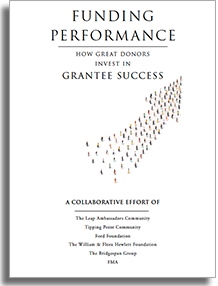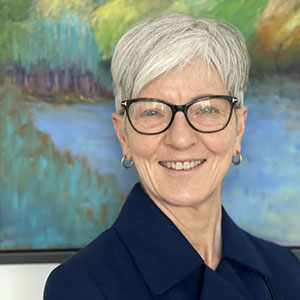Our hope is that foundations will one day look back on the COVID-19 pandemic as a turning point in the long-running conundrum of how to end the nonprofit "starvation cycle."
Must Read
The Leap Ambassadors Community monograph, Funding Performance: How Great Donors Invest in Grantee Success, features essays from "respected thinkers and doers" who explore the best and worst funding practices in the sector.
Download the monograph >>
Momentum for change gathered steam late in 2019. That's when presidents from five of the nation's largest foundations announced a plan to stop underfunding grantees’ indirect costs, a widespread practice that inspired the "starvation cycle" moniker. Ford Foundation President Darren Walker described the joint effort as a breakthrough and hoped that it would spark a broader movement.
At the time, five major foundations acting in concert to end chronic nonprofit underfunding garnered widespread attention. The prospect of several hundred pledging to go even further to change deeply ingrained grantmaking practices was unimaginable. But that was before COVID-19.
By late April 2020, in the midst of a pandemic wreaking economic havoc and taxing the ability of nonprofits to serve their constituents, almost 800 foundations signed a far-reaching call-to-action pledge. Among other things, they committed to loosening or eliminating restrictions on current grants and making new grants as unrestricted as possible. In a moment of crisis, the philanthropic community rose to the occasion and agreed to practices that reform-minded critics have urged for years: more trust and fewer onerous restrictions on how nonprofits spend their grants.
It remains to be seen whether, when the pandemic crisis passes, foundations will fall back on old habits. We certainly hope not.
The case for change has been building for years, led by groups such as the Center for Effective Philanthropy, Independent Sector, the Nonprofit Finance Fund, the RAND Corporation, the Urban Institute, and many others—including our organization, The Bridgespan Group. Even before we published “The Nonprofit Starvation Cycle” in 2009, we heard the anguished voices of grantees stymied by the failure of foundations to cover the actual costs of the work. A number expressed their experiences privately for fear that airing their concerns publicly would reduce the chance of funding. We’ll never forget the leader of one of the largest advocacy organizations in the U.S. saying she felt like a “dog with a collar” when it came to negotiating cost reimbursement with multiple program officers at a major foundation. Or the former investment banker who said he could never tell his funders the truth about his indirect-cost rate, which justifiably exceeded 15 percent. Across the nonprofit sector, the unequal power dynamic between funders and grantees stood in the way of frank conversations about funding. As a result, very little changed.
Inspired by voices from the field, and mindful of the complexities of foundation practice, we set out to build the fact base. In four discrete research efforts through 2019, we found evidence of a pervasive pattern of deeply ingrained funding practices that undercut nonprofit financial health and effectiveness. Through sustained and successive efforts, building on work by many others, we have helped to build a compelling case that the way most foundations fund nonprofits correlates with financial instability. In short, here’s what we found.
Most grants are restricted.
Three-quarters of U.S. foundation giving, and most NGO and government funding globally, comes in the form of restricted grants that limit what grantees can spend on non-program-related indirect costs. These include capabilities essential for achieving impact, such as executive leadership, information technology, strategic planning, and knowledge management. It’s standard practice for most foundations to cap indirect costs at 15 percent or less. For instance, seven of the 15 largest U.S. foundations currently post on their websites an indirect-cost reimbursement policy of 15 percent or less. Many global funders limit indirect-cost reimbursement to between 5 percent and 8 percent.
Indirect-cost reimbursement falls short.
Evidence belies practice. Rigorous analysis shows that actual indirect-cost rates (i.e., the ratio of indirect or shared costs to direct costs) are consistently higher than 15 percent and vary significantly depending on factors such as business model, scale, and geographic location. This analysis, first published in “Pay-What-It-Takes Philanthropy” in 2016, has been replicated three times, including by independent accounting firms. The actual median indirect-cost rate for one sample of 20 well-known nonprofits and NGOs turned out to be 40 percent. A recent analysis of more than 130,000 nonprofits’ IRS 990 financial forms found a similar pattern, with the minimum indirect-cost rate for “financially healthy” organizations being around 30 percent.
These limits on indirect costs leave nonprofits with a significant financial gap to fill. In our recent study, leading foundations covered, on average, only 88 cents on every dollar a sample of their grantees actually spent to carry out project restricted programs and services. Foundations are, in essence, telling nonprofits to make do on a budget that leaves out essential expenditures, so the more they spend, the farther behind they fall.
Chronic underfunding leaves nonprofits financially weak.
Shortchanging indirect costs undermines the financial health of the organizations funders have chosen to support. This was the shocking conclusion of our rigorous examination of the financial health of the 274 most strategically important and highly co-funded nonprofits of the 15 largest U.S. foundations. Many of these nonprofits are household names. More than half (53 percent) suffered from frequent or chronic budget deficits, and 40 percent had less than three months of reserves in the bank to cushion financial shortfalls. In fact, 30 of the 274 organizations were technically insolvent. COVID-19’s widespread effects are further exacerbating these financial challenges. We can’t solve society’s most pressing problems on the backs of financially stressed nonprofits, despite their Herculean efforts.
The challenges transcend restricted grants.
Even foundations that don’t have flat-rate indirect-cost policies can unintentionally shortchange nonprofits by granting too little money to cover actual costs. This came as a surprise to one large foundation that presumed its grants fully funded its grantees. In a pilot project with a funder collaborative, a third-party accounting firm determined that the foundation actually paid 83 cents on the dollar for the grant under review—a gap similar to the one created by flat-rate funders.
Systems-change efforts also suffer from unrealistic funding restrictions, the subject of a recent Ashoka report. Ashoka calls for fundamentally rethinking and redesigning the way funders support systems-change efforts.
The need for race-conscious solutions is even more acute.
In a 2016 Bridgespan sample of 29 nonprofits, we learned that factors other than impact determine cost recovery. White-led organizations were more likely to achieve full-cost recovery than organizations led by people of color. While the sample wasn’t large enough to be statistically significant, the findings were consistent with the patterns of discrimination that have already been well documented. That observation led us to team up with Echoing Green to conduct a rigorous analysis of funding patterns for organizations led by people of color. The research concluded that racial bias—both personal and institutional, conscious and unconscious—creeps into all parts of the philanthropic and grantmaking process. The result is that similarly qualified nonprofit organizations led by people of color receive less money than those led by whites. For example, in a sample of promising early-stage organizations, the revenues of the Black-led organizations were 24 percent smaller and the unrestricted net assets a whopping 76 percent smaller than those of their white-led counterparts. The stark disparity in unrestricted assets is particularly startling, as such funding often represents a proxy for trust.
With definitive evidence of the problem and its contours, we can and must address it.
For the five foundation presidents who agreed to change their funding practices in late 2019, the hard work of implementing solutions to chronic underfunding was just beginning when COVID-19 struck. In short order, the economic shock of nationwide shelter-in-place orders sent the nonprofit sector into survival mode. The pledge signed by hundreds of foundations threw nonprofits a lifeline fashioned out of more than a decade of research and advocacy. We know what works:
- Provide flexible funding built on trusting grantees to spend their grants wisely
- Commit to the principle of paying your fair share. That is, pay for the actual direct costs of a project plus a fair share of associated indirect costs and operational costs.
- Provide multiyear funding that enables grantees to plan for operational and financial sustainability.
Changing the status quo and adopting these approaches will require funders and grantees to have honest and constructive conversations about actual funding needs and true costs. By and large those conversations aren’t happening today, given the power imbalance between funders and grantees—an imbalance that’s even more acute when grantees are led by people of color. This must change. The power imbalance needs to be upended.
COVID-19 may have set that shift in motion. The hundreds of funders who signed the pledge agreed to give up some power—the power that’s expressed through grant restrictions. We admit it will take hard work to sustain and extend this shift, but vanguard foundations that have made flexibility and equity a North Star (e.g., Libra, Weingart, and Mulago Foundations) show the way forward.
Let’s not waste what is now the world’s largest experiment in flexible grantmaking. What does flexibility enable grantees to accomplish that they otherwise could not? Clearly, the pre-pandemic status quo wasn’t working—from financially undermining grantees to discriminating against organizations run by people of color. Maybe we’ve reached a tipping point for fundamental change. The crisis that inspired hundreds of foundations to pledge more trust and fewer grant restrictions may prove to be the catalyst that ushered in a new era of grantmaking.
Jeri Eckhart Queenan is a partner at The Bridgespan Group.
Jeff Bradach is Bridgespan’s managing partner and co-founder.


